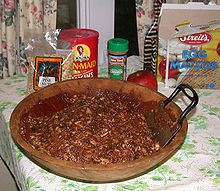
Back Charoset Catalan Charoset Czech Charosset German Jaroset Spanish هاروست Persian חרוסת HE ハローセト Japanese Charosèt JV Charoset Dutch Haróset NN
 | |
| Alternative names | duqqa, dukah, dukeh |
|---|---|
| Course | Sweet relish |
| Place of origin | Land of Israel |
| Region or state | Jewish Diaspora, Ashkenaz, Sepharad, Israel |
| Main ingredients | Apples, pears, raisins, Figs, Orange juice, Red wine, Pine nuts and Cinnamon |
| Variations | Dates, walnuts, sesame, wine vinegar, cinnamon, black pepper, marjoram |


1. Zeroa (shankbone)
2. Beitza (roasted hard-boiled egg)
3. Maror/Chazeret (horseradish)
4. Maror/Chazeret (onion)
5. Charoset
6. Karpas (parsley)

Charoset, haroset, or charoises (Hebrew: חֲרֽוֹסֶת, romanized: ḥəróseṯ, Yiddish: חרוסת, romanized: kheróyses) is a sweet, dark-colored mixture of finely chopped fruits and nuts eaten at the Passover Seder. According to the Talmud, its color and texture are meant to recall mortar (or mud used to make adobe bricks), which the Israelites used when they were enslaved in Ancient Egypt, as mentioned in Tractate Pesahim 116a of the Talmud. The word comes from the Hebrew word for clay (Hebrew: חֶרֶס, romanized: ḥéres).[1]
Charoset is one of the symbolic foods on the Passover Seder Plate. After reciting the blessings, and eating first maror dipped in charoset and then a matzah "Hillel sandwich" (with two matzot) combining charoset and maror, people often eat the remainder spread on matzah.[1][2]
- ^ a b "Seder Preparations - Jewish Tradition". yahadut.org. Retrieved 2024-03-30.
- ^ "03. The Seder Plate – Peninei Halakha". Retrieved 2024-03-30.
© MMXXIII Rich X Search. We shall prevail. All rights reserved. Rich X Search